OpenVINO を使用した YOLOv10 の変換と最適化#
この Jupyter ノートブックは、ローカルへのインストール後にのみ起動できます。
リアルタイムのオブジェクト検出は、低レイテンシーで画像内のオブジェクトのカテゴリーと位置を正確に予測することを目的としています。YOLO シリーズは、パフォーマンスと効率性のバランスにより、この研究の最前線にあります。しかし、NMS への依存とアーキテクチャーの非効率性により、最適なパフォーマンスが妨げられていました。YOLOv10 は、NMS フリーのトレーニングの一貫したデュアル割り当てと、全体的な効率と精度を重視したモデル設計戦略を導入することで、これらの問題に対処します。
清華大学の研究者によって Ultralytics Python パッケージ上に構築された YOLOv10 は、リアルタイムのオブジェクト検出に対する新しいアプローチを導入し、以前の YOLO バージョンの後処理とモデル・アーキテクチャーの欠陥に対処します。YOLOv10 は、非最大抑制 (NMS) を排除し、さまざまなモデル・コンポーネントを最適化することで、計算オーバーヘッドを大幅に削減し最先端のパフォーマンスを実現します。広範囲にわたる実験により、複数のモデルスケールにおいて優れた精度とレイテンシーのトレードオフが実証されています。
yolov10-approach.png#
モデル・アーキテクチャーの詳細については、オリジナルのリポジトリー、論文、Ultralytics ドキュメントを参照してください。
このチュートリアルでは、OpenVINO を使用して PyTorch YOLO V10 を実行および最適化する手順を段階的に説明します。
このチュートリアルは次のステップで構成されます:
PyTorch モデルの準備
PyTorch モデルを OpenVINO IR に変換
OpenVINO でモデル推論を実行
NNCF を使用して最適化パイプラインの準備と実行
FP16 モデルと量子化モデルのパフォーマンスを比較します。
ビデオで最適化されたモデル推論を実行
インタラクティブな Gradio デモを起動
目次:
必要条件#
import os
os.environ["GIT_CLONE_PROTECTION_ACTIVE"] = "false"
%pip install -q "nncf>=2.11.0"
%pip install --pre -Uq openvino --extra-index-url https://storage.openvinotoolkit.org/simple/wheels/nightly
%pip install -q "git+https://github.com/THU-MIG/yolov10.git" --extra-index-url https://download.pytorch.org/whl/cpu
%pip install -q "torch>=2.1" "torchvision>=0.16" tqdm opencv-python "gradio>=4.19" --extra-index-url https://download.pytorch.org/whl/cpuWARNING: Skipping openvino as it is not installed.
WARNING: Skipping openvino-dev as it is not installed.
Note: you may need to restart the kernel to use updated packages.
Note: you may need to restart the kernel to use updated packages.
Note: you may need to restart the kernel to use updated packages.
Note: you may need to restart the kernel to use updated packages.from pathlib import Path
# `notebook_utils` モジュールを取得
import requests
r = requests.get(
url="https://raw.githubusercontent.com/openvinotoolkit/openvino_notebooks/latest/utils/notebook_utils.py",
)
open("notebook_utils.py", "w").write(r.text)
from notebook_utils import download_filePyTorch モデルをダウンロード#
モデル作成者によって提供される YOLO V10 モデルには、いくつかのバージョンがあります。それぞれ、トレーニング・パラメーターの数、パフォーマンス、精度に応じて異なる特性を持ちます。デモには yolov10n を使用しますが、同じ手順は YOLO V10 シリーズの他のモデルにも適用できます。
models_dir = Path("./models")
models_dir.mkdir(exist_ok=True)model_weights_url = "https://github.com/jameslahm/yolov10/releases/download/v1.0/yolov10n.pt"
file_name = model_weights_url.split("/")[-1]
model_name = file_name.replace(".pt", "")
download_file(model_weights_url, directory=models_dir)'models/yolov10n.pt' already exists.PosixPath('/home/ea/work/openvino_notebooks_new_clone/openvino_notebooks/notebooks/yolov10-optimization/models/yolov10n.pt')PyTorch モデルを OpenVINO IR 形式にエクスポート#
前述したように、YOLO V10 コードは Ultralytics ライブラリーをベースに設計されており、YOLO V8 と同様のインターフェイスを備えています (Ultralytics API の使用方法の詳細手順については、YOLO V8 ノートブックを参照してください)。Ultralytics は、モデルクラスのエクスポート・メソッドを使用して OpenVINO モデルのエクスポートをサポートします。さらに、ターゲット入力サイズ、静的または動的入力形状、モデル精度 (FP32/FP16/INT8) を決定するパラメーターを指定することもできます。INT8 量子化はエクスポート・ステージで追加で実行できますが、アプローチをより柔軟にするため、NNCF を使用して量子化を実行する方法を検討します。
import types
from ultralytics.utils import ops, yaml_load, yaml_save
from ultralytics import YOLOv10
import torch
detection_labels = {
0: "person",
1: "bicycle",
2: "car",
3: "motorcycle",
4: "airplane",
5: "bus",
6: "train",
7: "truck",
8: "boat",
9: "traffic light",
10: "fire hydrant",
11: "stop sign",
12: "parking meter",
13: "bench",
14: "bird",
15: "cat",
16: "dog",
17: "horse",
18: "sheep",
19: "cow",
20: "elephant",
21: "bear",
22: "zebra",
23: "giraffe",
24: "backpack",
25: "umbrella",
26: "handbag",
27: "tie",
28: "suitcase",
29: "frisbee",
30: "skis",
31: "snowboard",
32: "sports ball",
33: "kite",
34: "baseball bat",
35: "baseball glove",
36: "skateboard",
37: "surfboard",
38: "tennis racket",
39: "bottle",
40: "wine glass",
41: "cup",
42: "fork",
43: "knife",
44: "spoon",
45: "bowl",
46: "banana",
47: "apple",
48: "sandwich",
49: "orange",
50: "broccoli",
51: "carrot",
52: "hot dog",
53: "pizza",
54: "donut",
55: "cake",
56: "chair",
57: "couch",
58: "potted plant",
59: "bed",
60: "dining table",
61: "toilet",
62: "tv",
63: "laptop",
64: "mouse",
65: "remote",
66: "keyboard",
67: "cell phone",
68: "microwave",
69: "oven",
70: "toaster",
71: "sink",
72: "refrigerator",
73: "book",
74: "clock",
75: "vase",
76: "scissors",
77: "teddy bear",
78: "hair drier",
79: "toothbrush",
}
def v10_det_head_forward(self, x):
one2one = self.forward_feat([xi.detach() for xi in x], self.one2one_cv2, self.one2one_cv3)
if not self.export:
one2many = super().forward(x)
if not self.training:
one2one = self.inference(one2one)
if not self.export:
return {"one2many": one2many, "one2one": one2one}
else:
assert self.max_det != -1
boxes, scores, labels = ops.v10postprocess(one2one.permute(0, 2, 1), self.max_det, self.nc)
return torch.cat(
[boxes, scores.unsqueeze(-1), labels.unsqueeze(-1).to(boxes.dtype)],
dim=-1,
)
else:
return {"one2many": one2many, "one2one": one2one}
ov_model_path = models_dir / f"{model_name}_openvino_model/{model_name}.xml"
if not ov_model_path.exists():
model = YOLOv10(models_dir / file_name)
model.model.model[-1].forward = types.MethodType(v10_det_head_forward, model.model.model[-1])
model.export(format="openvino", dynamic=True, half=True)
config = yaml_load(ov_model_path.parent / "metadata.yaml")
config["names"] = detection_labels
yaml_save(ov_model_path.parent / "metadata.yaml", config)Ultralytics API を使用して AUTO デバイスで OpenVINO 推論を実行#
これで、モデルを OpenVINO にエクスポートすることで、YOLOv10 クラスに直接ロードできるようになりました。自動推論バックエンドにより、元の PyTorch モデルと同様のレベルで OpenVINO YOLOv10 モデルを実行する使いやすいユーザー・エクスペリエンスが提供されます。以下のコードは、Ultralytics API を使用して単一のイメージで推論 OpenVINO エクスポート・モデルを実行する方法を示しています。モデルの起動には AUTO デバイスが使用されます。
ov_yolo_model = YOLOv10(ov_model_path.parent, task="detect")from PIL import Image
IMAGE_PATH = Path("./data/coco_bike.jpg")
download_file(
url="https://storage.openvinotoolkit.org/repositories/openvino_notebooks/data/data/image/coco_bike.jpg",
filename=IMAGE_PATH.name,
directory=IMAGE_PATH.parent,
)'data/coco_bike.jpg' already exists.PosixPath('/home/ea/work/openvino_notebooks_new_clone/openvino_notebooks/notebooks/yolov10-optimization/data/coco_bike.jpg')res = ov_yolo_model(IMAGE_PATH, iou=0.45, conf=0.2)
Image.fromarray(res[0].plot()[:, :, ::-1])Loading models/yolov10n_openvino_model for OpenVINO inference...
requirements: Ultralytics requirement ['openvino>=2024.0.0'] not found, attempting AutoUpdate...
requirements: ❌ AutoUpdate skipped (offline)
Using OpenVINO LATENCY mode for batch=1 inference...
image 1/1 /home/ea/work/openvino_notebooks_new_clone/openvino_notebooks/notebooks/yolov10-optimization/data/coco_bike.jpg: 640x640 1 bicycle, 2 cars, 1 motorcycle, 1 dog, 72.0ms
Speed: 25.6ms preprocess, 72.0ms inference, 0.6ms postprocess per image at shape (1, 3, 640, 640)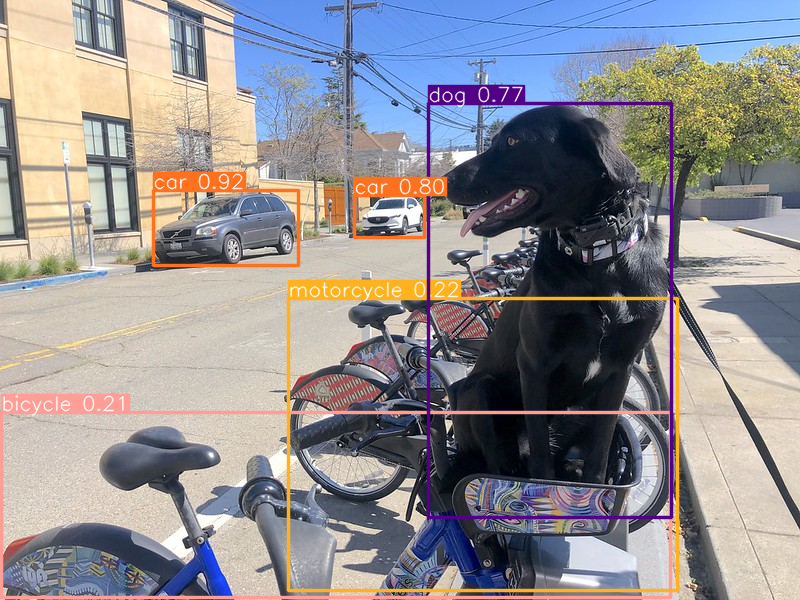
Ultralytics API を使用して選択したデバイスで OpenVINO 推論を実行#
このノートブックでは、モデル推論を実行するため推論デバイスを選択して、結果を AUTO と比較できます。
import openvino as ov
import ipywidgets as widgets
core = ov.Core()
device = widgets.Dropdown(
options=core.available_devices + ["AUTO"],
value="CPU",
description="Device:",
disabled=False,
)
deviceDropdown(description='Device:', options=('CPU', 'GPU.0', 'GPU.1', 'AUTO'), value='CPU')ov_model = core.read_model(ov_model_path)
# 選択したデバイスにモデルをロード
if "GPU" in device.value or "NPU" in device.value:
ov_model.reshape({0: [1, 3, 640, 640]})
ov_config = {}
if "GPU" in device.value:
ov_config = {"GPU_DISABLE_WINOGRAD_CONVOLUTION": "YES"}
det_compiled_model = core.compile_model(ov_model, device.value, ov_config)ov_yolo_model.predictor.model.ov_compiled_model = det_compiled_modelres = ov_yolo_model(IMAGE_PATH, iou=0.45, conf=0.2)image 1/1 /home/ea/work/openvino_notebooks_new_clone/openvino_notebooks/notebooks/yolov10-optimization/data/coco_bike.jpg: 640x640 1 bicycle, 2 cars, 1 motorcycle, 1 dog, 29.1ms
Speed: 3.2ms preprocess, 29.1ms inference, 0.3ms postprocess per image at shape (1, 3, 640, 640)Image.fromarray(res[0].plot()[:, :, ::-1])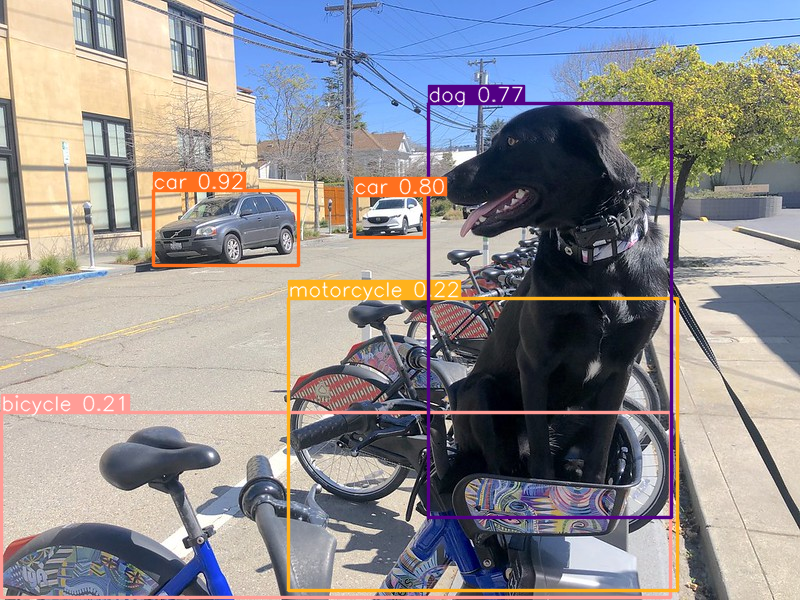
NNCF トレーニング後の量子化 API を使用してモデルを最適化#
NNCF は、精度の低下を最小限に抑えながら、OpenVINO でニューラル・ネットワーク推論を最適化する一連の高度なアルゴリズムを提供します。YOLOv10 を最適化するため、ポストトレーニング・モード (微調整パイプラインなし) で 8 ビット量子化を使用します。
最適化プロセスには次の手順が含まれます:
量子化用のデータセットを作成します。
nncf.quantizeを実行して、最適化されたモデルを取得します。openvino.save_model関数を使用して、OpenVINO IR モデルをシリアル化します。
量子化は時間とメモリーを消費するプロセスです。以下のチェックボックスでこの手順をスキップできます:
import ipywidgets as widgets
int8_model_det_path = models_dir / "int8" / f"{model_name}_openvino_model/{model_name}.xml" ov_yolo_int8_model = None
to_quantize = widgets.Checkbox(
value=True,
description="Quantization",
disabled=False,
)
to_quantizeCheckbox(value=True, description='Quantization')# skip_kernel_extension モジュールを取得
r = requests.get(
url="https://raw.githubusercontent.com/openvinotoolkit/openvino_notebooks/latest/utils/skip_kernel_extension.py",
)
open("skip_kernel_extension.py", "w").write(r.text)
%load_ext skip_kernel_extension量子化データセットを準備#
量子化を開始するには、データセットを準備する必要があります。モデルの量子化には MS COCO データセットの検証サブセットを使用し、入力データの準備には Ultralytics 検証データローダーを使用します。
%%skip not $to_quantize.value
from zipfile import ZipFile
from ultralytics.data.utils import DATASETS_DIR
if not int8_model_det_path.exists():
DATA_URL = "http://images.cocodataset.org/zips/val2017.zip"
LABELS_URL = "https://github.com/ultralytics/yolov5/releases/download/v1.0/coco2017labels-segments.zip"
CFG_URL = "https://raw.githubusercontent.com/ultralytics/ultralytics/v8.1.0/ultralytics/cfg/datasets/coco.yaml"
OUT_DIR = DATASETS_DIR
DATA_PATH = OUT_DIR / "val2017.zip"
LABELS_PATH = OUT_DIR / "coco2017labels-segments.zip"
CFG_PATH = OUT_DIR / "coco.yaml"
download_file(DATA_URL, DATA_PATH.name, DATA_PATH.parent)
download_file(LABELS_URL, LABELS_PATH.name, LABELS_PATH.parent)
download_file(CFG_URL, CFG_PATH.name, CFG_PATH.parent)
if not (OUT_DIR / "coco/labels").exists():
with ZipFile(LABELS_PATH, "r") as zip_ref:
zip_ref.extractall(OUT_DIR)
with ZipFile(DATA_PATH, "r") as zip_ref:
zip_ref.extractall(OUT_DIR / "coco/images")%%skip not $to_quantize.value
from ultralytics.utils import DEFAULT_CFG
from ultralytics.cfg import get_cfg
from ultralytics.data.converter import coco80_to_coco91_class
from ultralytics.data.utils import check_det_dataset
if not int8_model_det_path.exists():
args = get_cfg(cfg=DEFAULT_CFG)
args.data = str(CFG_PATH)
det_validator = ov_yolo_model.task_map[ov_yolo_model.task]["validator"](args=args)
det_validator.data = check_det_dataset(args.data)
det_validator.stride = 32
det_data_loader = det_validator.get_dataloader(OUT_DIR / "coco", 1)NNCF は、量子化パイプラインでネイティブ・フレームワーク・データローダーを使用する nncf.Dataset ラッパーを提供します。さらに、モデルが期待する形式で入力データを準備する変換関数を指定します。
%%skip not $to_quantize.value
import nncf
from typing import Dict
def transform_fn(data_item:Dict):
"""
Quantization transform function. Extracts and preprocess input data from dataloader item for quantization.
Parameters:
data_item: Dict with data item produced by DataLoader during iteration
Returns:
input_tensor: Input data for quantization
"""
input_tensor = det_validator.preprocess(data_item)['img'].numpy()
return input_tensor
if not int8_model_det_path.exists():
quantization_dataset = nncf.Dataset(det_data_loader, transform_fn)INFO:nncf:NNCF initialized successfully.サポートされているフレームワークが検出されました : torch, openvinoINT8 モデルを量子化して保存#
nncf.quantize 関数は、モデル量子化のインターフェイスを提供します。OpenVINO モデルのインスタンスと量子化データセットが必要です。オプションで、量子化プロセスの追加パラメーター (量子化のサンプル数、プリセット、無視される範囲など) を提供できます。YOLOv10 モデルには、活性化の非対称量子化を必要とする非 ReLU 活性化関数が含まれています。さらに良い結果を得るため、混合量子化プリセットを使用します。これは、重みの対称量子化と活性化の非対称量子化を提供します。
注: モデルのトレーニング後の量子化は時間のかかるプロセスです。ハードウェアによっては数分かかる場合があります。
%%skip not $to_quantize.value
import shutil
if not int8_model_det_path.exists():
quantized_det_model = nncf.quantize(
ov_model,
quantization_dataset,
preset=nncf.QuantizationPreset.MIXED,
)
ov.save_model(quantized_det_model, int8_model_det_path)
shutil.copy(ov_model_path.parent / "metadata.yaml", int8_model_det_path.parent / "metadata.yaml")最適化されたモデル推論を実行#
INT8 量子化モデルの使用方法は、量子化前のモデルと同じです。単一画像での量子化モデルの推論結果を確認してみます
AUTO デバイスで最適化モデルを実行#
%%skip not $to_quantize.value
ov_yolo_int8_model = YOLOv10(int8_model_det_path.parent, task="detect")%%skip not $to_quantize.value
res = ov_yolo_int8_model(IMAGE_PATH, iou=0.45, conf=0.2)Loading models/int8/yolov10n_openvino_model for OpenVINO inference...
requirements: Ultralytics requirement ['openvino>=2024.0.0'] not found, attempting AutoUpdate...
requirements: ❌ AutoUpdate skipped (offline)
Using OpenVINO LATENCY mode for batch=1 inference...
image 1/1 /home/ea/work/openvino_notebooks_new_clone/openvino_notebooks/notebooks/yolov10-optimization/data/coco_bike.jpg: 640x640 1 bicycle, 3 cars, 2 motorcycles, 1 dog, 92.3ms
Speed: 3.7ms preprocess, 92.3ms inference, 0.4ms postprocess per image at shape (1, 3, 640, 640)Image.fromarray(res[0].plot()[:, :, ::-1])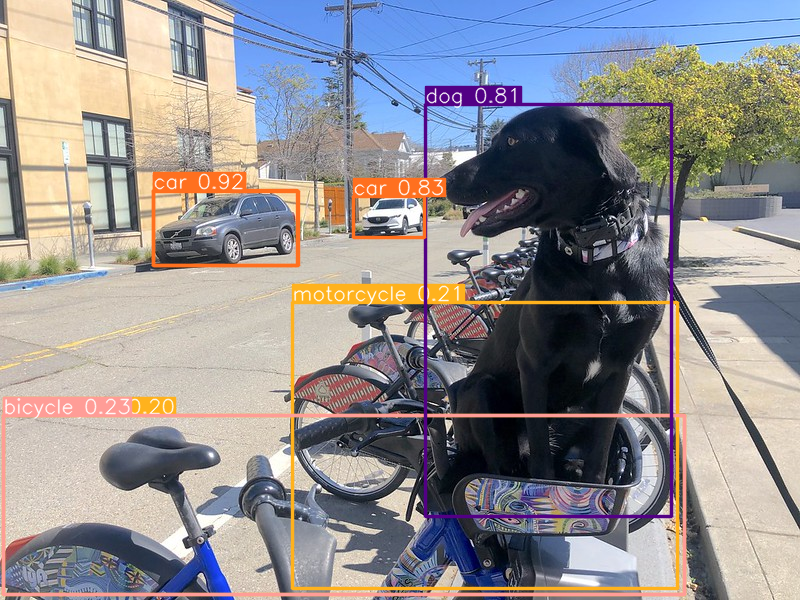
選択したデバイスで最適化されたモデル推論を実行#
%%skip not $to_quantize.value
device%%skip not $to_quantize.value
ov_config = {}
if "GPU" in device.value or "NPU" in device.value:
ov_model.reshape({0: [1, 3, 640, 640]})
ov_config = {}
if "GPU" in device.value:
ov_config = {"GPU_DISABLE_WINOGRAD_CONVOLUTION": "YES"}
quantized_det_model = core.read_model(int8_model_det_path)
quantized_det_compiled_model = core.compile_model(quantized_det_model, device.value, ov_config)
ov_yolo_int8_model.predictor.model.ov_compiled_model = quantized_det_compiled_model
res = ov_yolo_int8_model(IMAGE_PATH, iou=0.45, conf=0.2)image 1/1 /home/ea/work/openvino_notebooks_new_clone/openvino_notebooks/notebooks/yolov10-optimization/data/coco_bike.jpg: 640x640 1 bicycle, 3 cars, 2 motorcycles, 1 dog, 26.5ms
Speed: 7.4ms preprocess, 26.5ms inference, 0.3ms postprocess per image at shape (1, 3, 640, 640)Image.fromarray(res[0].plot()[:, :, ::-1])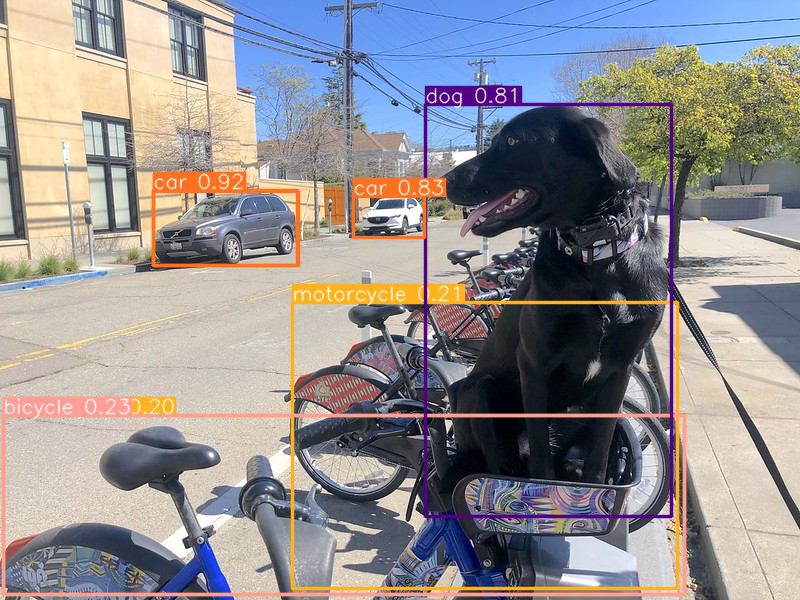
元のモデルと量子化モデルを比較#
モデルサイズ#
ov_model_weights = ov_model_path.with_suffix(".bin")
print(f"Size of FP16 model is {ov_model_weights.stat().st_size / 1024 / 1024:.2f} MB")
if int8_model_det_path.exists():
ov_int8_weights = int8_model_det_path.with_suffix(".bin")
print(f"Size of model with INT8 compressed weights is {ov_int8_weights.stat().st_size / 1024 / 1024:.2f} MB")
print(f"Compression rate for INT8 model: {ov_model_weights.stat().st_size / ov_int8_weights.stat().st_size:.3f}")Size of FP16 model is 4.39 MB
Size of model with INT8 compressed weights is 2.25 MB
Compression rate for INT8 model: 1.954パフォーマンス#
FP16 モデルのパフォーマンス#
!benchmark_app -m $ov_model_path -d $device.value -api async -shape "[1,3,640,640]" -t 15[Step 1/11] Parsing and validating input arguments [ INFO ] Parsing input parameters [Step 2/11] Loading OpenVINO Runtime [ INFO ] OpenVINO: [ INFO ] Build .................................2024.2.0-15496-17f8e86e5f2-releases/2024/2 [ INFO ] [ INFO ] Device info: [ INFO ] CPU [ INFO ] Build .................................2024.2.0-15496-17f8e86e5f2-releases/2024/2 [ INFO ] [ INFO ] [Step 3/11] Setting device configuration [ WARNING ] Performance hint was not explicitly specified in command line.Device(CPU) performance hint will be set to PerformanceMode.THROUGHPUT. [Step 4/11] Reading model files [ INFO ] Loading model files [ INFO ] Read model took 31.92 ms [ INFO ] Original model I/O parameters: [ INFO ] Model inputs: [ INFO ] x (node: x) : f32 / [...]/ [?,3,?,?] [ INFO ] Model outputs: [ INFO ] *NO_NAME* (node: __module.model.23/aten::cat/Concat_8) : f32 / [...] / [?,300.6] [Step 5/11] Resizing model to match image sizes and given batch [ INFO ] Model batch size: 1 [ INFO ] Reshaping model: 'x': [1,3,640,640] [ INFO ] Reshape model took 17.77 ms [Step 6/11] Configuring input of the model [ INFO ] Model inputs: [ INFO ] x (node: x) : u8 / [N,C,H,W] / [1,3,640,640] [ INFO ] Model outputs: [ INFO ] *NO_NAME* (node: __module.model.23/aten::cat/Concat_8) : f32 / [...] / [1,300,6] [Step 7/11] Loading the model to the device [ INFO ] Compile model took 303.83 ms [Step 8/11] Querying optimal runtime parameters [ INFO ] Model: [ INFO ] NETWORK_NAME: Model0 [ INFO ] OPTIMAL_NUMBER_OF_INFER_REQUESTS: 12 [ INFO ] NUM_STREAMS: 12 [ INFO ] INFERENCE_NUM_THREADS: 36 [ INFO ] PERF_COUNT: NO [ INFO ] SCHEDULING_CORE_TYPE: <Type: 'float32'> [ INFO ] PERFORMANCE_HINT: THROUGHPUT [ INFO ] EXECUTION_MODE_HINT: ExecutionMode. PERFORMANCE [ INFO ] PERFORMANCE_HINT_NUM_REQUESTS: 0 [ INFO ] ENABLE_CPU_PINNING: True [ INFO ] SCHEDULING_CORE_TYPE: SchedulingCoreType.ANY_CORE [ INFO ] MODEL_DISTRIBUTION_POLICY: set() [ INFO ] ENABLE_HYPER_THREADING: True [ INFO ] EXECUTION_DEVICES: ['CPU'] [ INFO ] CPU_DENORMALS_OPTIMIZATION: False [ INFO ] LOG_LEVEL: Level. NO [ INFO ] CPU_SPARSE_WEIGHTS_DECOMPRESSION_RATE: 1.0 [ INFO ] DYNAMIC_QUANTIZATION_GROUP_SIZE: 0 [ INFO ] KV_CACHE_PRECISION: <Type: 'float16'> [ INFO ] AFFINITY: Affinity.CORE [Step 9/11] Creating infer requests and preparing input tensors [ WARNING ] No input files were given for input 'x'!.This input will be filled with random values! [ INFO ] Fill input 'x' with random values [Step 10/11] Measuring performance (Start inference asynchronously, 12 inference requests, limits: 15000 ms duration) [ INFO ] Benchmarking in inference only mode (inputs filling are not included in measurement loop). [ INFO ] First inference took 30.60 ms [Step 11/11] Dumping statistics report [ INFO ] Execution Devices:['CPU'] [ INFO ] Count: 2424 iterations [ INFO ] Duration: 15093.22 ms [ INFO ] Latency: [ INFO ] Median: 72.34 ms [ INFO ] Average: 74.46 ms [ INFO ] Min: 45.87 ms [ INFO ] Max: 147.25 ms [ INFO ] Throughput: 160.60 FPS
Int8 モデルのパフォーマンス#
if int8_model_det_path.exists():
!benchmark_app -m $int8_model_det_path -d $device.value -api async -shape "[1,3,640,640]" -t 15[Step 1/11] Parsing and validating input arguments [ INFO ] Parsing input parameters [Step 2/11] Loading OpenVINO Runtime [ INFO ] OpenVINO: [ INFO ] Build .................................2024.2.0-15496-17f8e86e5f2-releases/2024/2 [ INFO ] [ INFO ] Device info: [ INFO ] CPU [ INFO ] Build .................................2024.2.0-15496-17f8e86e5f2-releases/2024/2 [ INFO ] [ INFO ] [Step 3/11] Setting device configuration [ WARNING ] Performance hint was not explicitly specified in command line.Device(CPU) performance hint will be set to PerformanceMode.THROUGHPUT. [Step 4/11] Reading model files [ INFO ] Loading model files [ INFO ] Read model took 38.75 ms [ INFO ] Original model I/O parameters: [ INFO ] Model inputs: [ INFO ] x (node: x) : f32 / [...]/ [?,3,?,?] [ INFO ] Model outputs: [ INFO ] *NO_NAME* (node: __module.model.23/aten::cat/Concat_8) : f32 / [...]/ [?,300.6] [Step 5/11] Resizing model to match image sizes and given batch [ INFO ] Model batch size: 1 [ INFO ] Reshaping model: 'x': [1,3,640,640] [ INFO ] Reshape model took 18.33 ms [Step 6/11] Configuring input of the model [ INFO ] Model inputs: [ INFO ] x (node: x) : u8 / [N,C,H,W] / [1,3,640,640] [ INFO ] Model outputs: [ INFO ] *NO_NAME* (node: __module.model.23/aten::cat/Concat_8) : f32 / [...]/ [1,300,6] [Step 7/11] Loading the model to the device [ INFO ] Compile model took 622.99 ms [Step 8/11] Querying optimal runtime parameters [ INFO ] Model: [ INFO ] NETWORK_NAME: Model0 [ INFO ] OPTIMAL_NUMBER_OF_INFER_REQUESTS: 18 [ INFO ] NUM_STREAMS: 18 [ INFO ] INFERENCE_NUM_THREADS: 36 [ INFO ] PERF_COUNT: NO [ INFO ] SCHEDULING_CORE_TYPE: <Type: 'float32'> [ INFO ] PERFORMANCE_HINT: THROUGHPUT [ INFO ] EXECUTION_MODE_HINT: ExecutionMode. PERFORMANCE [ INFO ] PERFORMANCE_HINT_NUM_REQUESTS: 0 [ INFO ] ENABLE_CPU_PINNING: True [ INFO ] SCHEDULING_CORE_TYPE: SchedulingCoreType.ANY_CORE [ INFO ] MODEL_DISTRIBUTION_POLICY: set() [ INFO ] ENABLE_HYPER_THREADING: True [ INFO ] EXECUTION_DEVICES: ['CPU'] [ INFO ] CPU_DENORMALS_OPTIMIZATION: False [ INFO ] LOG_LEVEL: Level. NO [ INFO ] CPU_SPARSE_WEIGHTS_DECOMPRESSION_RATE: 1.0 [ INFO ] DYNAMIC_QUANTIZATION_GROUP_SIZE: 0 [ INFO ] KV_CACHE_PRECISION: <Type: 'float16'> [ INFO ] AFFINITY: Affinity.CORE [Step 9/11] Creating infer requests and preparing input tensors [ WARNING ] No input files were given for input 'x'!.This input will be filled with random values! [ INFO ] Fill input 'x' with random values [Step 10/11] Measuring performance (Start inference asynchronously, 18 inference requests, limits: 15000 ms duration) [ INFO ] Benchmarking in inference only mode (inputs filling are not included in measurement loop). [ INFO ] First inference took 28.26 ms [Step 11/11] Dumping statistics report [ INFO ] Execution Devices:['CPU'] [ INFO ] Count: 5886 iterations [ INFO ] Duration: 15067.10 ms [ INFO ] Latency: [ INFO ] Median: 44.39 ms [ INFO ] Average: 45.89 ms [ INFO ] Min: 29.73 ms [ INFO ] Max: 110.52 ms [ INFO ] Throughput: 390.65 FPS
ライブデモ#
次のコードは、ビデオに対してモデル推論を実行します:
import collections
import time
from IPython import display
import cv2
import numpy as np
# 物体検出を実行するメイン処理関数
def run_object_detection(
source=0,
flip=False,
use_popup=False,
skip_first_frames=0,
det_model=ov_yolo_int8_model,
device=device.value,
):
player = None
try:
# ターゲット fps で再生するビデオプレーヤーを作成
player = VideoPlayer(source=source, flip=flip, fps=30, skip_first_frames=skip_first_frames)
# キャプチャー開始
player.start()
if use_popup:
title = "Press ESC to Exit"
cv2.namedWindow(winname=title, flags=cv2.WINDOW_GUI_NORMAL | cv2.WINDOW_AUTOSIZE)
processing_times = collections.deque()
while True:
# フレームをグラブ
frame = player.next()
if frame is None:
print("Source ended")
break
# フレームがフル HD より大きい場合は、サイズを縮小してパフォーマンスを向上させます
scale = 1280 / max(frame.shape)
if scale < 1:
frame = cv2.resize(
src=frame,
dsize=None,
fx=scale,
fy=scale,
interpolation=cv2.INTER_AREA,
)
# 結果を取得
input_image = np.array(frame)
start_time = time.time()
detections = det_model(input_image, iou=0.45, conf=0.2, verbose=False)
stop_time = time.time()
frame = detections[0].plot()
processing_times.append(stop_time - start_time)
# 最後の 200 フレームの処理時間を使用
if len(processing_times) > 200:
processing_times.popleft()
_, f_width = frame.shape[:2]
# 平均処理時間 [ms]
processing_time = np.mean(processing_times) * 1000
fps = 1000 / processing_time
cv2.putText(
img=frame,
text=f"Inference time: {processing_time:.1f}ms ({fps:.1f} FPS)",
org=(20, 40),
fontFace=cv2.FONT_HERSHEY_COMPLEX,
fontScale=f_width / 1000,
color=(0, 0, 255),
thickness=1,
lineType=cv2.LINE_AA,
)
# ちらつきがある場合はこの回避策を使用
if use_popup:
cv2.imshow(winname=title, mat=frame)
key = cv2.waitKey(1)
# escape = 27
if key == 27:
break
else:
# numpy 配列を jpg にエンコード
_, encoded_img = cv2.imencode(ext=".jpg", img=frame, params=[cv2.IMWRITE_JPEG_QUALITY, 100])
# IPython イメージを作成
i = display.Image(data=encoded_img)
# このノートブックに画像を表示
display.clear_output(wait=True)
display.display(i)
# ctrl-c
except KeyboardInterrupt:
print("Interrupted")
# 異なるエラー
except RuntimeError as e:
print(e)
finally:
if player is not None:
# キャプチャーを停止
player.stop().stop()
if use_popup:
cv2.destroyAllWindows()use_int8 = widgets.Checkbox(
value=ov_yolo_int8_model is not None,
description="Use int8 model",
disabled=ov_yolo_int8_model is None,
)
use_int8Checkbox(value=True, description='Use int8 model')WEBCAM_INFERENCE = False
if WEBCAM_INFERENCE: VIDEO_SOURCE = 0 # ウェブカメラ
else:
download_file(
"https://storage.openvinotoolkit.org/repositories/openvino_notebooks/data/data/video/people.mp4",
directory="data",
)
VIDEO_SOURCE = "data/people.mp4"'data/people.mp4' already exists.Run_object_detection((
det_model=ov_yolo_model if not use_int8.value else ov_yolo_int8_model,
source=VIDEO_SOURCE,
flip=True,
use_popup=False,
)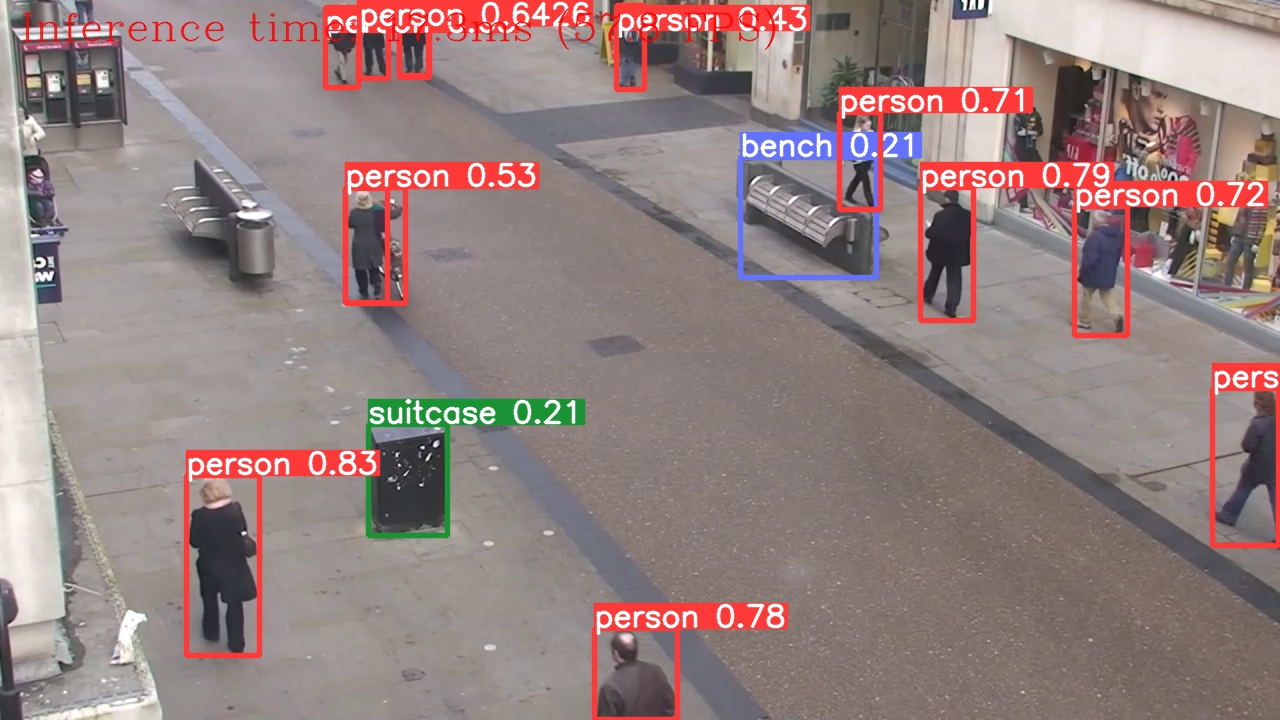
ソースの終わりインタラクティブな Gradio デモを起動#
import gradio as gr
def yolov10_inference(image, int8, conf_threshold, iou_threshold):
model = ov_yolo_model if not int8 else ov_yolo_int8_model
results = model(source=image, iou=iou_threshold, conf=conf_threshold, verbose=False)[0]
annotated_image = Image.fromarray(results.plot())
return annotated_image
with gr.Blocks() as demo:
gr.HTML(
"""
<h1 style='text-align: center'>
YOLOv10: Real-Time End-to-End Object Detection using OpenVINO
</h1>
"""
)
with gr.Row():
with gr.Column():
image = gr.Image(type="numpy", label="Image")
conf_threshold = gr.Slider(
label="Confidence Threshold",
minimum=0.1,
maximum=1.0,
step=0.1,
value=0.2,
)
iou_threshold = gr.Slider(
label="IoU Threshold",
minimum=0.1,
maximum=1.0,
step=0.1,
value=0.45,
)
use_int8 = gr.Checkbox(
value=ov_yolo_int8_model is not None,
visible=ov_yolo_int8_model is not None,
label="Use INT8 model",
)
yolov10_infer = gr.Button(value="Detect Objects")
with gr.Column():
output_image = gr.Image(type="pil", label="Annotated Image")
yolov10_infer.click(
fn=yolov10_inference,
inputs=[
image,
use_int8,
conf_threshold,
iou_threshold,
],
outputs=[output_image],
)
examples = gr.Examples(
[
"data/coco_bike.jpg",
],
inputs=[
image,
],
)
try:
demo.launch(debug=False)
except Exception:
demo.launch(debug=False, share=True)